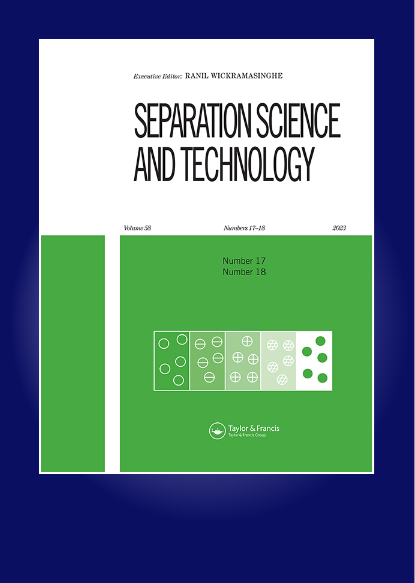掺杂al的Fe3O4纳米颗粒对水溶液中锑的高效去除:吸附行为和动力学研究
IF 2.3
4区 工程技术
Q3 CHEMISTRY, MULTIDISCIPLINARY
引用次数: 0
摘要
Fe3O4磁性纳米颗粒作为一种经济高效的吸附剂用于去除水溶液中的Sb。但其有限的吸附能力和聚集性限制了其广泛应用。在本研究中,通过简单的溶剂热方法制备了掺杂al的Fe3O4纳米颗粒,突破了电流障碍。采用x射线衍射(XRD)、x射线光电子能谱(XPS)、扫描电镜(SEM)和红外光谱(FTIR)对掺杂al的Fe3O4纳米颗粒进行了表征。结果证实,Al原子被成功地掺杂到Fe3O4晶胞中,得到了更小的颗粒尺寸、更大的表面积和更高的等电点。这些变化导致掺杂al的Fe3O4纳米颗粒表面形成更多的羟基。与原始Fe3O4相比,在中性pH下,对Sb(III)和Sb(V)的最大吸附量分别从111.695和34.479增加到197.034 mg/g和187.459 mg/g。Al的掺杂对原磁性强度也有一定的负面影响,但仍保持了足够的磁分离电位。这些结果表明,掺杂al的Fe3O4纳米颗粒可以作为去除废水中Sb(III)和Sb(V)的吸附剂。本文章由计算机程序翻译,如有差异,请以英文原文为准。
Efficient removal of antimony from aqueous solution using Al-doped Fe3O4 nanoparticles: adsorption behavior and kinetics study
ABSTRACT Fe3O4 magnetic nanoparticles have been employed as a cost-effective adsorbent for removing Sb from aqueous solutions. However, the widespread application is limited by its finite adsorption capacity and aggregation nature. In this study, Al-doped Fe3O4 nanoparticles were prepared via a facile solvothermal method to break through the current obstacle. Al-doped Fe3O4 nanoparticles were fully characterized by X-ray diffraction (XRD), X-ray photoelectron spectroscopy (XPS), Scanning Electron microscopy (SEM), and infrared spectroscopy (FTIR). The results confirmed that Al atoms had been successfully doped into Fe3O4 crystal unit cells, resulting in smaller particle size, larger surface area, and higher isoelectric point. These changes led to the formation of more hydroxyl groups on the surface of Al-doped Fe3O4 nanoparticles. Compared to pristine Fe3O4, the maximum adsorption capacity toward Sb(III) and Sb(V) increased from 111.695 to 197.034 mg/g and from 34.479 to 187.459 mg/g at neutral pH, respectively. The doping of Al also had some negative impact on the original magnetic strength but still maintained a sufficient magnetic separation potential. These results indicated that Al-doped Fe3O4 nanoparticles could be employed as a promising adsorbent for removing Sb(III) and Sb(V) from wastewater.
求助全文
通过发布文献求助,成功后即可免费获取论文全文。
去求助
来源期刊

Separation Science and Technology
工程技术-工程:化工
CiteScore
6.10
自引率
3.60%
发文量
131
审稿时长
5.7 months
期刊介绍:
This international journal deals with fundamental and applied aspects of separation processes related to a number of fields. A wide range of topics are covered in the journal including adsorption, membranes, extraction, distillation, absorption, centrifugation, crystallization, precipitation, reactive separations, hybrid processes, continuous separations, carbon capture, flocculation and magnetic separations. The journal focuses on state of the art preparative separations and theoretical contributions to the field of separation science. Applications include environmental, energy, water, and biotechnology. The journal does not publish analytical separation papers unless they contain new fundamental contributions to the field of separation science.
 求助内容:
求助内容: 应助结果提醒方式:
应助结果提醒方式:


